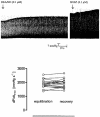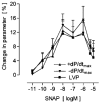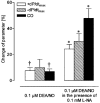Inhibition of nitric oxide synthase augments the positive inotropic effect of nitric oxide donors in the rat heart
- PMID: 10639106
- PMCID: PMC2269760
- DOI: 10.1111/j.1469-7793.2000.00311.x
Inhibition of nitric oxide synthase augments the positive inotropic effect of nitric oxide donors in the rat heart
Abstract
1. In this investigation we studied the effects of nitric oxide on contractility and heart rate in normal saline-perfused rat hearts where shear stress-induced endothelial NO synthesis substantially contributes to total cardiac NO production. In addition, we sought to estimate the concentrations of exogenous NO producing inotropic effects. 2. We investigated the effects of glyceryl trinitrate (GTN), S-nitroso-d,l-penicillamine (SNAP), sodium (Z)-1-(N, N-diethylamino)diazen-1-ium-1,2-diolat (DEA/NO), and DEA/NO in the presence of the NO synthase inhibitor Nomega-nitro-L-arginine (L-NA) in constant-flow-perfused spontaneously beating rat Langendorff hearts and in rat working hearts. 3. In Langendorff hearts, GTN (10 nM to 100 microM, n = 32) induced a positive inotropic response that plateaued at 1 microM GTN with a maximal rate of increase of left ventricular pressure during ventricular contraction (+dP/dtmax) of 6. 33 +/- 2.56 % (n = 11, P < 0.5). Similarly, both spontaneous NO donors (0.1 nM to 1 microM, corresponding to approximately 0.03-0.3 microM NO) induced a positive inotropic response of 10.6 +/- 3.1 % (SNAP; n = 15, P < 0.05) and 11.5 +/- 2.7 % (DEA/NO, n = 15, P < 0. 05). 4. The positive inotropic effect of SNAP and DEA/NO progressively declined from 1 microM to 100 microM of the NO donors (corresponding to approximately 0.3-30 microM NO). 5. In the isolated working rat heart, 0.1 microM DEA/NO induced an increase of +dP/dtmax of 7.5 +/- 2.5 % (n = 9, P < 0.05). Inhibition of NO synthase by L-NA produced a 4-fold increase in this effect of DEA/NO. 6. We suggest that physiological NO concentrations support myocardial performance. In normal rat hearts the positive inotropic effect of NO appears to be almost maximally exploited by the endogenous NO production.
Figures






References
-
- Ahlner J, Andersson RGG, Torfgård K, Axelsson KL. Organic nitrate esters: Clinical use and mechanisms of actions. Pharmacological Reviews. 1991;43:351–423. - PubMed
-
- Arnold G, Kosche F, Miessner A, Neitzert A, Lochner W. The importance of the perfusion pressure in the coronary arteries for the contractility and the oxygen consumption of the heart. Pflügers Archiv. 1968;299:339–356. - PubMed
-
- Balligand J-L, Kobzik L, Han X, Kaye DM, Belhassen L, O'hara DS, Kelly RA, Smith TW, Michel T. Nitric oxide-dependent parasympathetic signaling is due to activation of constitutive endothelial (type III) nitric oxide synthase in cardiac myocytes. Journal of Biological Chemistry. 1995;270:14582–14586. - PubMed
-
- Balligand JL, Ungureanu-Longrois D, Simmons WW, Pimental D, Malinski TA, Kapturczak M, Taha Z, Lowenstein CJ, Davidoff AJ, Kelly RA, Smith TW, Michel T. Cytokine-inducible nitric oxide synthase (iNOS) expression in cardiac myocytes. Characterization and regulation of iNOS expression and detection of iNOS activity in single cardiac myocytes in vitro. Journal of Biological Chemistry. 1994;269:27580–27588. - PubMed
-
- Borzak S, Murphy S, Marsh JD. Mechanisms of rate staircase in rat ventricular cells. American Journal of Physiology. 1991;260:H884–892. - PubMed
Publication types
MeSH terms
Substances
LinkOut - more resources
Full Text Sources

